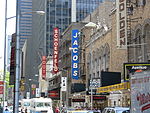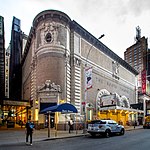Marquis Theatre

The Marquis Theatre is a Broadway theater on the third floor of the New York Marriott Marquis hotel in the Theater District of Midtown Manhattan in New York City. Opened in 1986, it is operated by the Nederlander Organization. There are 1,612 seats in the auditorium, spread across an orchestra level and a balcony. The Marquis was designed by John C. Portman Jr., who designed the Marriott Marquis and included the theater to increase the size of the hotel. The theater's main entrance and box office are at 210 West 46th Street. The box office is at ground level, and there are escalators leading from the ground floor to the auditorium. Due to a lack of space, the wings on each side of the proscenium arch are smaller than mandated by city building codes. The theater also has no freight elevator, no dedicated restroom facilities, and small hallways. A theater was proposed on the site in 1973 as part of a hotel (later the Marriott Marquis), the completion of which was delayed until 1985. The hotel had controversially replaced several existing theaters, and the design features of the new Marquis Theatre were highly criticized, even by the hotel's supporters. The first major production at the Marquis, the long-running Me and My Girl, was followed by a series of short-lived productions in the 1990s and 2000s.
Excerpt from the Wikipedia article Marquis Theatre (License: CC BY-SA 3.0, Authors, Images).Marquis Theatre
Broadway, New York Manhattan
Geographical coordinates (GPS) Address Website Nearby Places Show on map
Geographical coordinates (GPS)
| Latitude | Longitude |
|---|---|
| N 40.758888888889 ° | E -73.986388888889 ° |
Address
New York Marriott Marquis (Marriott Marquis)
Broadway 1535
10019 New York, Manhattan
New York, United States
Open on Google Maps











